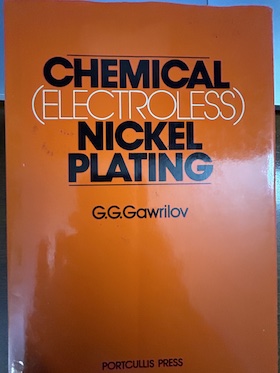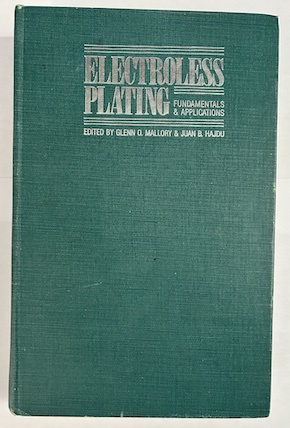
-----
Electroless Copper Plating on Alumina
Q. I am a researcher at the South Bank university Chemical engineering research center, and I would like to know how I can coat alumina, (aluminium oxide), particles with copper via an electroless process.
if however there is another way of coating the alumina with copper I would be interested in hearing it.
Thank you.
Fraz Uddin ChishtiSouth Bank University - London, U.K.
1996
A. You can plate alumina like you do ABS through etching, palladium-tin catalyst etc.
-- sara

Sara Michaeli
Tel-Aviv-Yafo, Israel
A. It might help if you mentioned the thickness you require. Most commonly, if you need a thick layer, and the part isn't too complex geometrically, you would first consider electroless copper followed by electroplated copper.
If, for some reason, you HAVE to use strictly electroless copper, why not replenish the copper, caustic, and reducer instead of making up new baths?
A freshly plated copper is quite active and will oxidize. You could use a benzotriazole
⇦ on
eBay
or
Amazon [affil links]
coat between electroless platings, but then you would have to reactivate the surface prior to the next plating.

James Totter, CEF
- Tallahassee, Florida
August 26, 2005
A. Dear James :
I suggest a 5% H2SO4 solution dip, after rinsing the parts and washing the electro-less Cu solution from them.
Take Care

Alireza Reyhan
- Istanbul, Turkey
June 7, 2010
Q. I am Dheeraj Varanasi, a student from Hungary. As part of my research work I need to carry out electroless deposition of Copper on Alumina substrate. I follow finishing.com and found it useful at more than one instance. So, I would like to know how much of HCl can be used to sensitize and activate the surface of Al2O3 substrate before i deposit Cu. I need thickness in range of nano-micro, so there is no problem of low thickness. Kindly help me.
Dheeraj Varanasi- Miskolc, Hungary
April 25, 2017
A. Hi cousin Dheeraj. It is my understanding that the HCl is only there as a carrier to maintain pH and make the deposition of the palladium possible. It is the palladium which deposits on the aluminum and acts as the catalyst to start the electroless copper deposition.
But if your interest is in building parts as opposed to developing chemistry, please be aware that these activating solutions are available as proprietary solutions from plating process vendors, and you may get better results from standard sequences of such processes which probably involve tin chloride followed by palladium chloride.
Mallory & Hajdu covers how this activation/catalyzing works in their Electroless Copper chapter. Sorry, I don't know whether alumina works differently than plastics in this activation sequence. Good luck.
Regards,

Ted Mooney, P.E. RET
Striving to live Aloha
finishing.com - Pine Beach, New Jersey
Q. I need electroless copper coating on surface of Alumina(Al2O3) substrate. Could you provide me the best way to activate the surface of Alumina, that does not involve PdCl Palladium Chloride. Alternate means of chemicals which can activate the surface. Thank you.
I am only asking for alternatives to Palladium as I am student and it is very costly to obtain it.
- Miskolc, Hungary
by G. G. Gawrilov

on AbeBooks
or eBay or
Amazon
(affil link)
A. Hi again Dheeraj. I think one alternative is to try to find a vendor of plating-on-plastics process chemistry and see if you can get help. I'm not on top of developments, but I understand that graphite based and organo-metallic metallizing solutions are replacing palladium chloride in some applications. But these processes are the product of years of intense closely-guarded privately funded research, so it would be a matter of buying those proprietary chemicals not trying to find out how to make them. Best of luck.
Regards,

Ted Mooney, P.E. RET
Striving to live Aloha
finishing.com - Pine Beach, New Jersey
April 28, 2017
A. I have been able copper plate a form of Alumina Al2O3 (anodized aluminum articles to be precise), so my experience is limited to that -- but it may prove to be an viable alternative to you.
These are the steps for Anodized sheet of aluminum:
Degrease and clean the surface, sensitize the surface with a standard stannous chloride sensitizer solution (3 grams of stannous chloride, 5 ml of HCl, and enough DI Water to make 1 L of solution).
Rinse the article(don't let it dry) and while is wet apply a standard silver mirroring solution( tollen's reagent, brashear process)
After the Silver layer has been applied I was able to coat it with a strong copper layer using the simple but tested 'galvanic copper backing 'layer for silver mirrors. How it works? Make the recently Silvered alumina come in contact with very fine iron or zinc powdered metal and apply a standard copper sulphate
⇦ on
eBay or
Amazon [affil links] solution. By way of galvanic electrical contact (standard electrode potential difference between Silver, Iron/Zinc and Copper electrolyte) will deposit a copper layer on the Silvered Alumina.
A video of such process(coating a recently silvered mirror with copper, the only one I could find on the web:
Another way would be by skipping the Silvering and use a Silver Nitrate Activating solution instead of Palladium chloride.
Very good reading here
http://www.ibchem.com/IB/ibe/ibe_doc/Cumirror.doc.
- Managua, Nicaragua
|
|
November 27, 2017 Q. Hello everyone, Microelectronics - Salamanca, Spain A. Hi Javier. Electroplating copper onto aluminum is a quite different thing than electrolessly depositing copper onto alumina, but it is done by the acre every day, and we have numerous discussion threads on the subject. Please search the site for 'copper plating on aluminum' and a quick review may solve the problem. If not, you can follow up on one of the applicable threads. Luck & Regards,  Ted Mooney, P.E. RET Striving to live Aloha finishing.com - Pine Beach, New Jersey |
Q, A, or Comment on THIS thread -or- Start a NEW Thread
